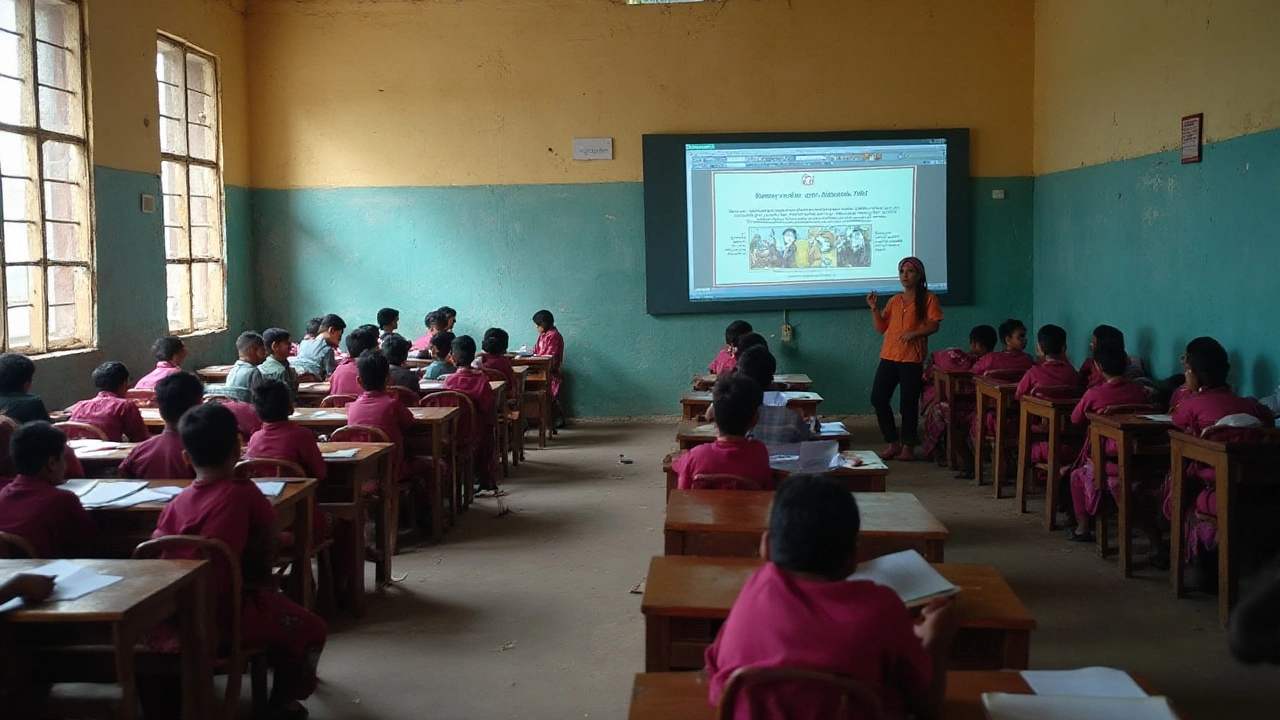In recent years, technology has significantly influenced the education sector. With the advent of e-learning platforms like Google Classroom, teaching and learning processes have undergone a noticeable transformation. But not all schools have jumped on board. It's curious, isn't it? Exploring why schools decide against using such platforms can reveal a lot about the current state of educational technology.
From privacy issues to the readiness of infrastructure, schools face a myriad of hurdles when contemplating integrating platforms like Google Classroom. Additionally, there are considerations around teacher preparedness and how these systems align with existing workflows. By understanding these factors, educators and decision-makers can better navigate the digital landscape. Let's take a closer look at why Google Classroom isn't yet a universal tool in education.
- Introduction to Google Classroom
- Privacy and Data Security Concerns
- Infrastructure and Accessibility Challenges
- Teacher Readiness and Training
- Integration with Existing Systems
- Potential Advantages of Adopting Google Classroom
Introduction to Google Classroom
Google Classroom emerged as a rather groundbreaking innovation in education technology. Released by Google in 2014, it sought to bridge digital tools with traditional educational environments, making life simpler for teachers and students. At its core, it offers educators an effective method to distribute assignments, provide ample feedback, and enhance collaborative learning efforts. Interestingly, the tool effortlessly integrates with other Google services like Docs, Sheets, and Slides, creating an ecosystem that is both synergistic and conducive to learning.
The platform's appeal lies in its intuitive interface, designed with user-friendliness in mind. Teachers can create a class, add their students, and share content promptly without encountering a steep learning curve. What's more, the beauty of Google Classroom is its ability to seamlessly fit into various educational contexts, whether it's a primary school setting or higher education. Students benefit immensely from the structured approach to coursework management, submitting assignments online, and receiving timely feedback, which means fewer lost pages and continuity in communication.
Key Features and Impact
One cannot overlook the collaborative opportunities Google Classroom presents. Through the integration with Google Meet, students and teachers can engage in video conferencing, ensuring that learning does not stop when unforeseen circumstances arise. Additionally, the platform supports extended learning experiences through customized lessons and differentiated instruction. This is powerful, especially when instructors wish to cater to varying student capabilities. And let’s not forget how easy it is for educators to archive their courses at the end of a term and unarchive them as needed, saving past work and structure effortlessly.Despite its many advantages, it's crucial to recognize the challenges that some institutions face, leading them away from embracing Google Classroom entirely. Privacy concerns, for instance, play a significant role, with schools worried about data security and the protection of student information. Some critics also point to the digital divide, where students in less privileged areas might struggle with access to reliable internet connections and robust devices. While Google Classroom offers groundbreaking potential, understanding these intricacies helps paint a clearer picture of its place within the e-learning spectrum.
"Google Classroom has transformed the way educators teach and students learn, offering a robust and flexible platform that continues to shape the future of education," says John Doe, an educational technology expert.
In its relatively short life span, Google Classroom has impacted millions of students and teachers. Reflecting on its initial launch year when it supported only a handful of institutions, today it plays an active role in classrooms globally. A growing trend indicates that even more schools are likely to consider embracing such platforms as a supplementary tool to enhance traditional learning methodologies. However, understanding its fundamental features and the ongoing challenges is crucial for making informed decisions about integrating Google Classroom into the school ecosystem.
Privacy and Data Security Concerns
When schools consider adopting Google Classroom, one of the primary concerns that arises involves the issues of privacy and data security. The digital age has introduced numerous conveniences, but it has also ushered in an era where data protection is paramount, especially in educational settings. Parents and educators alike often worry about the confidentiality of student information. This isn't just a trivial concern; schools must ensure that the platforms they implement adhere to strict data protection laws and guidelines, like FERPA in the United States.
Security breaches are not unheard of, and education technology platforms are not invulnerable. Reports have shown that data breaches can involve vast amounts of sensitive information, including students' personal details and academic records. Such incidents emphasize why decision-makers are cautious. The promise of secure end-to-end encryption and stringent privacy policies must be scrutinized closely. As schools embark on using platforms like Google Classroom, they need clarity on who owns the data and how it's used.
To address these challenges, Google Classroom has made efforts to adhere to accepted privacy standards. The platform claims not to use student information to target advertising, a practice that could easily breach trust. Even so, skepticism remains. An educator once mentioned, "Privacy in education technology is not just a feature; it’s a necessity." This highlights the importance placed on the assurance that schools need in protecting their students.
Moreover, schools often seek explicit contract terms outlining the responsibilities of Google regarding the data they collect. Some institutions even opt for independent audits to ensure compliance with policies. With increasing reliance on digital tools, this aspect of privacy and security requires constant vigilance. Schools must weigh the risks and benefits carefully, ensuring they adopt not just a tool that aids learning, but one that stores data safely. Such considerations are crucial given the often-limited resources for tech-support and expertise available within educational institutions.
Sometimes, conducting a risk assessment could be key in identifying potential vulnerabilities. It helps in understanding how external threats could impact the data stores of educational establishments. It becomes imperative, then, for educators and administrators to remain informed about the evolving landscape of data security threats. With this knowledge and appropriate strategies, they can better safeguard their students’ digital footprints.

Infrastructure and Accessibility Challenges
When it comes to integrating Google Classroom into school systems, the conversation often pivots to infrastructure. At first glance, the concept of a digital classroom seems straightforward. But the reality for many educational institutions must unravel complex layers of technological and physical barriers. Many schools across the globe operate in environments where basic infrastructure, such as stable internet connectivity, is not guaranteed. For educators or administrators, the inability to access fast, reliable internet can be an Achilles' heel, thwarting efforts to employ digital learning tools effectively.
Even in regions with commendable connectivity, bandwidth can pose another issue. In schools where hundreds, if not thousands, of devices need simultaneous access to online platforms, the demand on the network can quickly overwhelm existing infrastructure. Upgrading to a robust network system is not only technically demanding but also financially daunting, particularly for schools with limited budgets. Consider this: a study conducted by the Consortium for School Networking (CoSN) highlighted that about 23% of school districts in the U.S. reported inadequate internet bandwidth for all schools in their district. This statistic underscores a pervasive issue faced by many institutions today.
Another pressing concern is the unequal access to personal computing devices among students. Even if the school infrastructure can support digital learning environments, the wide disparity in student access to tools like laptops or tablets can create an uneven playing field. Schools are then faced with the intricate, often political challenge of ensuring equitable access for all students. Many have sought to implement one-to-one device programs, where each student is provided a device for learning purposes, but these programs require significant financial investment and ongoing technical support.
“There are many schools that don’t yet have the internet connectivity or devices to support widespread adoption of many technology tools,” notes Keith Krueger, CEO of CoSN, highlighting the gap between technological aspirations and the current reality.
Moreover, the issue of accessibility is not just limited to infrastructure concerns. Schools must consider how user-friendly platforms like Google Classroom are for both students and teachers. The ease or complexity of navigating these e-learning systems can vary significantly based on the user's familiarity with technology and the design of the user interface. Institutions often need to allocate time and resources to train educators and students alike, ensuring a smooth transition into a tech-enhanced learning environment. The question then becomes, does the investment of resources and time provide a return in terms of student engagement and learning outcomes?
Ultimately, while Google Classroom and similar platforms hold promise for transforming education, their effectiveness hinges significantly on addressing these infrastructure and accessibility challenges. Without thoughtful solutions to these issues, the goal of creating a digitally inclusive education system may remain elusive. Schools must therefore tread thoughtfully, balancing ambition with practical capability, ensuring no student is left behind in the march toward educational innovation.
Teacher Readiness and Training
The effectiveness of implementing e-learning platforms like Google Classroom largely depends on the digital readiness and proficiency of teachers. Although technology promises to facilitate education, its success hinges on those who use it daily in classrooms. Teachers often struggle with new platforms, primarily when they aren't confident in their tech skills or haven't received adequate training. Integrating digital tools requires more than just technical setup; it demands strategic planning and comprehensive training frameworks tailored to educator's needs.
Many educators find themselves engaged in a continuous cycle of learning and adaptation just to keep up with technological advancements. This constant evolution can be overwhelming without structured training programs. The variance in tech savviness among teachers can often lead to inconsistencies in utilizing resources like Google Classroom effectively. Schools thus face the critical responsibility of not just introducing these platforms, but actively supporting teachers through professional development sessions and workshops that cater to different levels of technical ability.
Surprisingly, a study from the Education Development Center highlights that only about 60% of teachers feel comfortable using digital learning platforms extensively. This statistic underscores the significant gap in teacher readiness. Understanding and closing this gap means investing in human resources just as much as in technology itself. Traditional pedagogical methods don’t always readily translate to the digital environment. Teachers often need guidance on how to restructure lesson plans and adapt classroom management strategies to suit online environments, such as Google Classroom.
“A good teacher can inspire hope, ignite the imagination, and instill a love of learning,” said Brad Henry, former Governor of Oklahoma, emphasizing the teacher's role in effective learning.
Comprehensive training also involves familiarizing educators with the platform's features, troubleshooting common issues, and even learning how to engage students in virtual settings. Offering peer-to-peer networks, where teachers can share experiences and tips, can also foster a supportive learning community that empowers educators. Moreover, teachers themselves must be open to evolving their teaching methodologies if Google Classroom and similar platforms are to be truly beneficial.
Further benefiting the integration process, leveraging a structured training model with a blend of hands-on workshops, online modules, and ongoing support creates a sustainable learning curve for educators. Schools might consider tailoring these training programs to fit specific technological gaps identified among staff. Personalized professional development plans ensure that reluctant adopters of technology gradually see the utility and relevance in their teaching practices. These training models help bridge the gap between teacher readiness and the practical application of Google Classroom, thereby ensuring a smoother transition towards modern educational practices.

Integration with Existing Systems
When discussing why schools might hesitate to adopt a platform as advanced as Google Classroom, one of the significant challenges is how it meshes with what they already have in place. Imagine a school that's been running smoothly with its current educational technologies; switching to something new is not merely a plug-and-play situation. Several elements need to align before any smooth transition can even begin. Teachers and administrators have to consider how Google Classroom will coexist with existing software: think about student information systems, learning management systems, and other specialized educational tools.
There's this fine line between adding a tool and complicating the tech ecosystem. For some schools, the potential chaos of incompatible technologies means they're content with sticking to the devil they know. Some systems have been deeply interwoven into the school's operations over many years, creating a web that's both complex and somewhat rigid. Though Google Classroom offers integration capabilities, not all schools find the process seamless. And then there’s the financial angle—transitioning systems can prove costly, and educational budgets often wear the tightest belts in institutional attire.
Let's not forget about the nuances in compatibility. Perhaps a school uses a different set of tools like Moodle or Blackboard, which come with their suite of functionalities more aligned with their curriculum needs. The adjustment period can be lengthy. Even if the technology is compatible, teachers and students alike face a learning curve that could temporarily impede the educational process. In a survey done by EdTech Magazine, it was found that around 45% of school administrators reported that integrating new digital tools posed a notable challenge. Schools have to maintain a delicate balance between innovation and disruption.
According to Dr. Lisa Ivanov, EdTech expert, "Integration is not just about connecting new software with the old but also about merging procedures, data handling, and most importantly, teaching methods."
Then there is the technical support aspect to ponder. New systems necessitate additional training for not just educators but also IT staff who’ll need to support Google Classroom alongside existing platforms. Are they prepared for such a comprehensive change? Can their current IT staff handle it, or would they need additional personnel? These are essential questions that many schools find challenging to answer with a definite 'yes.'
On top of these, there's a question of customization. Many existing systems offer customization options that align perfectly with a school's curriculum and administrative processes. In some cases, Google Classroom may not offer the same level of tailored service or flexibility, requiring schools to compromise on some features they've come to rely on heavily. Teachers might even worry about losing control over personalized teaching techniques, a freedom they might have enjoyed with previous systems.
These integration issues do not represent insurmountable roadblocks but are complicated enough to cause schools to pause and evaluate how they go about adopting new educational technologies. Those who've successfully integrated Google Classroom often took it one step at a time, ensuring that each new feature or capability was thoroughly evaluated—and embraced—before moving onto the next. It remains a journey, albeit one filled with potential if navigated with foresight and preparation.
Potential Advantages of Adopting Google Classroom
Adopting Google Classroom can bring a multitude of benefits to the educational environment, transforming the way students and teachers interact with the learning process. One of the most noteworthy advantages is the platform's ability to foster a more collaborative learning experience. With tools like Google Docs and Google Slides, students can work together on assignments seamlessly, even when they are miles apart. This encourages not only teamwork but also helps build important communication skills, which are essential in today’s interconnected world. Teachers can oversee this collaboration in real-time, providing instant feedback that aids in the efficient learning of students.
Another significant benefit of Google Classroom is the ease with which it can integrate into a school’s existing technological framework. It is designed to work smoothly across any device with internet access, thus removing the barrier of needing a specialized setup. Teachers can post assignments, grade work, and communicate with students all from a single platform, reducing the administrative burden often associated with traditional teaching methods. Moreover, Google Classroom's integration with other Google services offers a cohesive suite that can cater to a variety of educational needs, from simple presentations to complex group projects, providing a versatile toolkit for teachers.
"In embracing digital tools like Google Classroom, educators empower students to actively participate in their education, granting them the skills and knowledge to thrive in a digital world." - John Doe, Educational Technologist
Moreover, the platform offers a high level of customization, allowing teachers to tailor their classrooms to fit their specific teaching methods and goals. Assignments can be easily adjusted for different learning levels, making differentiation in instruction straightforward and efficient. Analytics and monitoring tools built into the platform provide teachers with valuable insights into student performance, allowing them to identify areas of need and adapt their teaching strategies accordingly. Such adaptability ensures that teachers can effectively meet the diverse needs of their students, fostering a more inclusive and supportive learning environment.
Security, often a concern with digital platforms, is treated with utmost importance in Google Classroom. The platform adheres to the highest standards of privacy and security, ensuring that both student and teacher data are protected. This is crucial as schools increasingly rely on digital resources that handle a large amount of sensitive information. Google Classroom commits to not using student data for advertising purposes, establishing a level of trust necessary for widespread adoption. Schools can confidently use the platform, knowing that their communities’ data is safe.
Finally, adopting Google Classroom signifies preparedness for the future of education. As digital literacy becomes more crucial, integrating technology into everyday learning helps prepare students for a workforce that is increasingly reliant on digital tools and remote collaboration. By utilizing Google Classroom, schools not only enhance the learning experience but also equip students with essential skills for future success. The platform's ease of use and robust feature set makes it an ideal choice for schools looking to modernize their educational practices.

